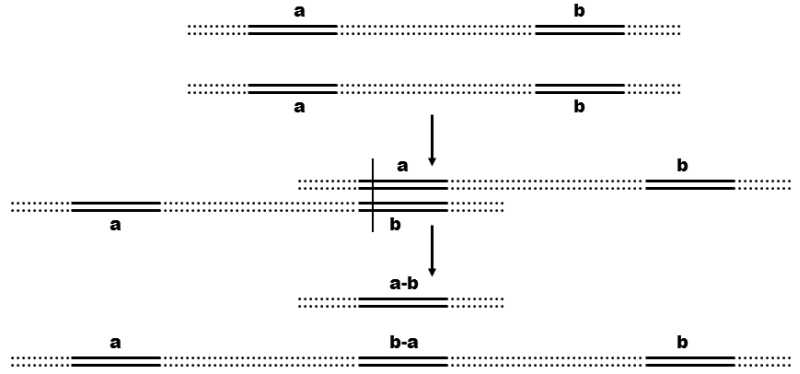VI.2.2.3 Unequal crossing-over can often result in multiplication of particular DNA sequences.
Unequal crossing‑over occurs when pairing occurs of two mutually complementary but simultaneously nonhomologous DNA segments, with subsequent crossing-over between them. If unequal crossing-over occurs in thea same DNA molecule, this leads to the formation of a single circular DNA molecule and deletion of the relevant DNA section from the original molecule (Fig. VI.5).
Unequal crossing-over between two DNA molecules, e.g. between DNA segments lying on two different chromosomes, leads to duplication of the given segment on one chromosome and its deletion on the other chromosome (Fig. VI.6).

Fig. VI.6. Multiplication of a DNA segment due to unequal crossing-over. If two segments with a high level of sequential homology are located at a suitable distance apart (in our case, segments a and b), it can readily occur that recombination between two segments that do not correspond to one another can occur during meiosis. This will lead to a situation where the particular segment with a high degree of homology and also the segment located between segments a and b will multiply in one of the recombined chromosomes. The corresponding DNA segment then disappears in the second recombined chromosome. Because the functioning of chromosomes with deletion is usually less than the functioning of chromosomes with duplication, chromosomes with genome duplication will gradually accumulate in the gene pool.
There is only apparent symmetry between duplication and deletion. Deletion is more frequently lethal than duplication, so that its bearers are more frequently removed from the population by natural selection. However, what is more important is that further duplication occurs with much greater probability in multiplied, e.g. duplicated, segments. This thus releases a positive feedback spiral that leads to the accumulation of an increasing number of duplicated segments in the genome of the organism and subsequently in the gene pool of the species.
